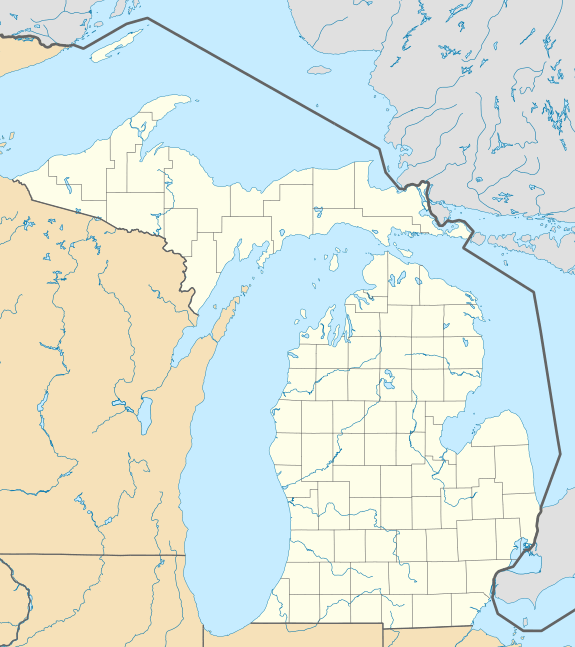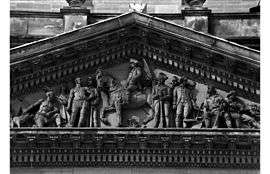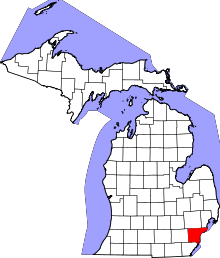Wayne County Building
|
Wayne County Courthouse | |
 | |
 Location in Michigan | |
| Location |
600 Randolph Street Detroit, Michigan |
|---|---|
| Coordinates | 42°19′56″N 83°02′33″W / 42.3321°N 83.0424°WCoordinates: 42°19′56″N 83°02′33″W / 42.3321°N 83.0424°W |
| Area | 2 acres (0.81 ha) |
| Built | 1897–1902 |
| Architect | John and Arthur Scott |
| Architectural style | Roman Baroque Revival, Beaux-Arts, Neoclassical, Classical Revival |
| NRHP Reference # | 75000972 |
| Significant dates | |
| Added to NRHP | February 24, 1975 |
| Designated MSHS | September 17, 1974 |
The Wayne County Building is a lowrise government structure located at 600 Randolph Street in Downtown Detroit, Michigan. It formerly contained the Wayne County administrative offices – now located in the Guardian Building at 500 Griswold Street – and its courthouse. As Wayne County Courthouse, it was listed on the National Register of Historic Places in 1975.[1] When it was completed in 1902, it was regarded as "one of the most sumptuous buildings in Michigan".[2]
Architecture
The building was designed by Detroit architects John and Arthur Scott.[3] Constructed from 1897 to 1902,[4] it may be one of the nation's finest surviving examples of Roman Baroque Revival architecture, with a blend of Beaux-Arts and some elements of the Neoclassical style.
The building stands 5 floors and was built using copper, granite, and stone. The exterior is profusely ornamented with sculpture; the interior is finished in a variety of woods, marbles, tiles, and mosaics.[5] Built with buff Berea sandstone, the façade features a rusticated basement story and a balustrade between the third and fourth stories. At the main entrance, a broad flight of stairs leads up to a two-story Corinthian column portico. The structure boasts a tall, four-tiered, hipped roof central tower balanced by end pavilions. The courthouse tower was originally 227' 8½" tall; the copper dome and spire were redone in the 1960s, bringing its height to 247 feet.
The exterior architectural sculpture, including the Anthony Wayne pediment, was executed by Detroit sculptor Edward Wagner. The other sculptures, two quadrigas, Victory and Progress and four figures on the tower, Law, Commerce, Agriculture, and Mechanics, were sculpted by New York sculptor J. Massey Rhind, and made by Salem, Ohio resident William H. Mullins in 1903.[6]
On the other end of Campus Martius was the old Detroit City Hall, and they adorned the landscape as 'bookends'.[3]
A renovation was carried out in 1987 by Quinn Evans Architects and Smith, Hinchman & Grylls Associates.[3][5]
Recent news
On July 18, 2007, Wayne County Executive Robert Ficano announced Wayne County had entered into an agreement to purchase the Guardian Building to relocate its offices from the Wayne County Building. This purchase would commence when the county's lease on their current home expires in 2008 and end a difficult tenant-landlord relationship between the owners and the County.[7] The Detroit Free Press print edition on July 21, 2007, carried a front page article about the current landlord offering a reduced rate for the county to remain.[8]
In July 2014, the Wayne County Commission approved the sale of the building along with a county-owned parking lot at 400 E. Fort Street to a New York investment group for $13.4 million. The building is expected to be renovated for single tenant occupancy.[9]
Gallery
 Victory and Progress
Victory and Progress
by J. Massey Rhind by J. Massey Rhind
by J. Massey Rhind by J. Massey Rhind
by J. Massey Rhind by J. Massey Rhind
by J. Massey Rhind by J. Massey Rhind
by J. Massey Rhind
 Spire
Spire One Detroit Center has similar architectural accents
One Detroit Center has similar architectural accents From Brush and Congress streets
From Brush and Congress streets- Renaissance Center with the Wayne County Building
 Wayne County Building in 1899
Wayne County Building in 1899
References
- ↑ National Park Service (2010-07-09). "National Register Information System". National Register of Historic Places. National Park Service.
- ↑ Marilyn Floreck (February 1974). "National Register of Historic Places Inventory/Nomination: Wayne County Building / Wayne County Courthouse". Retrieved July 5, 2016. (connection is slow to display)
- 1 2 3 Hill, Eric J. & John Gallagher (2002). AIA Detroit: The American Institute of Architects Guide to Detroit Architecture. Wayne State University Press. ISBN 0-8143-3120-3. P. 100.
- ↑ Old Wayne County Building. Historic Detroit. Retrieved on July 29, 2014.
- 1 2 Sharoff, Robert (2005). American City: Detroit Architecture, 1845-2005. Wayne State University Press. ISBN 0-8143-3270-6. P. 17.
- ↑ http://siris-artinventories.si.edu/ipac20/ipac.jsp?session=C43S80877649W.2641&profile=ariall&source=~!siartinventories&view=subscriptionsummary&uri=full=3100001~!18424~!3&ri=2&aspect=Browse&menu=search&ipp=20&spp=20&staffonly=&term=W.+H.+Mullins+Company,+fabricator.&index=AUTHOR&uindex=&aspect=Browse&menu=search&ri=2
- ↑ Gallager, John. Detroit Free Press. "Wayne Co. to buy Guardian Building for $14.5 million". (Accessed July 18, 2007).
- ↑ Detroit Free Press. "Landlord offers to drop county's rent if it stays". (Accessed July 21, 2007).
- ↑ Pinho, Kirk (18 July 2014). "N.Y. investment group to invest $15M on improvements at Old Wayne County Building". Crain's Business Detroit. Retrieved 20 July 2014.
Further reading
- Farbman, Suzy and James P. Gallagher (1989). The Renaissance of the Wayne County Building, Smith Hinchman & Grylls, Inc, The old Wayne County Building Limited Partnership and Walbridge Aldinger Company, Detroit, Michigan.
- Ferry, W. Hawkins (1968). The Buildings of Detroit: A History, Wayne State University Press.
- Gibson, Arthur Hopkin (1975). Artists of Early Michigan: A Biographical Dictionary of Artists Native to or Active in Michigan, 1701–1900, Wayne State University Press.
- Kvaran & Lockely, A Guide to the Architectural Sculpture in America, unpublished manuscript.
- Meyer, Katherine Mattingly and Martin C.P. McElroy with Introduction by W. Hawkins Ferry, Hon A.I.A. (1980). Detroit Architecture A.I.A. Guide Revised Edition. Wayne State University Press. ISBN 0-8143-1651-4.
- Nawrocki, Dennis Alan and Thomas J. Holleman (1980). Art in Detroit Public Places, Wayne State University Press.
- Sobocinski, Melanie Grunow (2005). Detroit and Rome: building on the past. Regents of the University of Michigan. ISBN 0-933691-09-2.
- Woodford, Arthur M. (2001). This is Detroit 1701–2001. Wayne State University Press. ISBN 0-8143-2914-4.
External links
| Wikimedia Commons has media related to Wayne County Building. |
- Wayne County Courthouse
- Wayne County Building details at Emporis.com
- SkyscraperPage.com's Profile on Wayne County Building
- Historic images from Detroit Public Library
